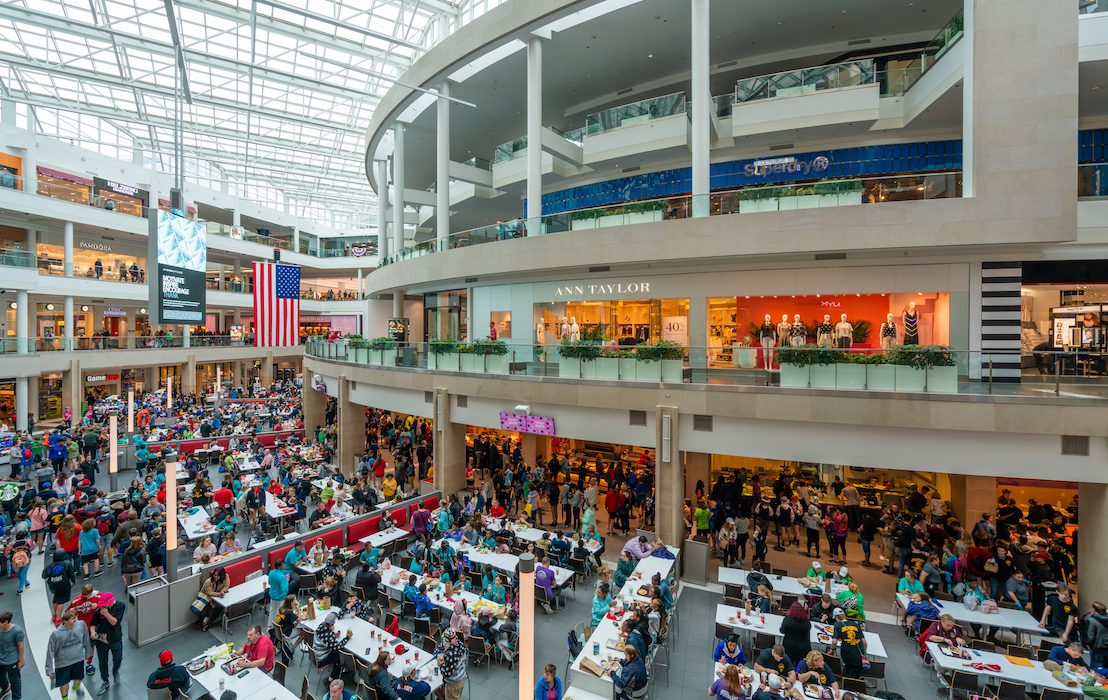Malls in the Afterlife

America is becoming a retail graveyard.
Before the pandemic, malls were dropping like flies. Anchor tenants like JCPenney, Sears, Kmart, and Toys’R’Us, which once provided malls with revenue streams and large customer bases, have either gone bankrupt or shrunk substantially. In 2017, one company predicted that 20 to 25 percent of the nation’s malls would close by 2022. The real number may well be higher today in the wake of the pandemic.
There is nothing quite like a mall. Antiseptic, climate-controlled, and completely lacking windows, its architectural style can only be described as “generic.” The mall obliterates time and space. It doesn’t matter if you go to a mall in Prince George’s, Maryland, or Peabody, Massachusetts, you’ll get the same experience.
Paradoxically, these products of the automobile age provided some of the only pedestrian experiences many of us had until college. There were no cars in the mall, but there were plenty of benches, varied “streetscapes,” and even a town square in the form of the food court. Another paradox: These temples of consumerism were also third spaces—neither work nor home, but totally social. You could stay in a mall all day with friends and never spend any money. It was a meeting space for different demographics—elderly mall-walkers, parents, bored college students home on break, teenagers working their first jobs. Everyone went to the mall sooner or later.
Now that many malls have died, the debate has turned to their future uses. In some parts of the country, their fate is certain: redevelopment. In Greater Boston, for example, any mall that closes will likely have multiple developers offering plans to redevelop the site for housing, life-science lab space, or some combination of the two, probably with some ground-floor retail.
Redevelopment will be high on the priority list for many real estate companies, but it may not be best for cities. These structures already exist, and the properties are depreciated enough that independent businesses could afford them. What small towns need is more creativity and less chain retail. One solution may be for malls to go back to the past.
Consider Huaqiangbei, a Chinese neighborhood known for its electronics parts stores, many of which are grouped into what some call a “mall” that is more like a marketplace. At first, Huaqiangbei seems to be like most malls—full of vendors, covering multiple floors and buildings—but it is actually a place with many individual electronics vendors, not just larger stores.
These sorts of locations aren’t unheard of in the U.S.—Micro Center is a good example, and older people may remember buying small electric motors, capacitors, and other parts at Radio Shack. But as a market place and a district, Huaqiangbei hearkens back to something much more decentralized. From the 1920s to the 1960s, in area of Lower Manhattan bounded by Veser, Liberty, Church and West Streets, a neighborhood of electronics parts and equipment dealers flourished. Known as Radio Row, some firms that began there eventually became large manufacturers and distributors of parts and equipment. It was eventually seized by the Port Authority via eminent domain and demolished to build the World Trade Center. It was the prototype of Huaqiangbei, Apliu Street in Hong Kong, Akihabara in Tokyo, Taipei’s Guang Hua Digital Plaza and Seoul’s Yongsan Electronics Market. These places are not only centers of retail, but of repair and even manufacturing.
But more than just small-scale retail, a dead mall could be revived for anything: small-scale manufacturing, indoor farmers’ markets, makerspaces, co-working spaces, tool libraries, and more. The correct approach is not, “How do we fill a 20,000 square foot space that used to be Sears?” but rather “How small can we subdivide all the space to spread the costs among as many tenants as possible?” In addition to developing businesses that may be too marginal or perceived as too risky to scale up to their own space right away, such an approach may also give developers the flexibility to earn income from the mall and redevelop the parking lot as housing or lab space or whatever might be in demand.
This approach may be just what communities need to revitalize dead malls. As Jane Jacobs wrote, “New ideas need old buildings.” As malls become the “old buildings” of our time, they should be prepared for new ideas.
Matthew Robare lives in Boston. This New Urbanism series is supported by the Richard H. Driehaus Foundation. Follow New Urbs on Twitter for a feed dedicated to TAC’s coverage of cities, urbanism, and place.
Comments